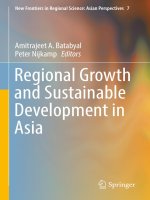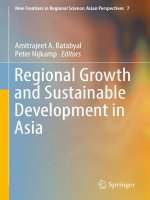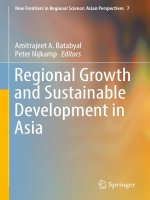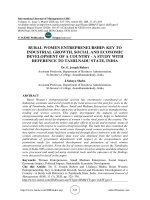Economic growth and economic development 191
Bạn đang xem bản rút gọn của tài liệu. Xem và tải ngay bản đầy đủ của tài liệu tại đây (44.14 KB, 1 trang )
Introduction to Modern Economic Growth
their North American neighbors are more prosperous thanks to their Anglo-Saxon
culture.
A related argument, originating in anthropology, argues that societies may become “dysfunctional” because their cultural values and their system of beliefs do
not encourage cooperation. An original and insightful version of this argument is
developed in Banfield’s (1958) analysis of poverty in Southern Italy. His ideas were
later picked up and developed by Putnam (1993), who suggested the notion of “social capital,” as a stand-in for cultural attitudes that lead to cooperation and other
“good outcomes”. Many versions of these ideas are presented in one form or another
in the economics literature as well.
Two challenges confront theories of economic growth based on culture. The
first is the difficulty of measuring culture. While both Putnam himself and some
economists have made some progress in measuring certain cultural characteristics
with self-reported beliefs and attitudes in social surveys, simply stating that the
North of Italy is rich because it has good social capital while the South is poor
because it has poor social capital runs the risk of circularity. The second difficulty
confronting cultural explanations is for accounting for growth miracles, such as those
of South Korea and Singapore. As mentioned above, if some Asian cultural values
are responsible for the successful growth experiences of these countries, it becomes
difficult to explain why these Asian values did not lead to growth before. Why
do these values not spur economic growth in North Korea? If Asian values are
important for Chinese growth today, why did they not lead to a better economic
performance under Mao’s dictatorship? Both of these challenges are, in principle,
surmountable. One may be able to develop models of culture, with better mapping
to data, and also with an associated theory of when and how culture may change
rapidly under certain circumstances, to allow stagnation to be followed by a growth
miracle. While possible in principle, such theories have not been developed yet.
Moreover, the evidence presented in the next section suggests that cultural effects
are not the major force behind the large differences in economic growth experienced
by many countries over the past few centuries.
177









